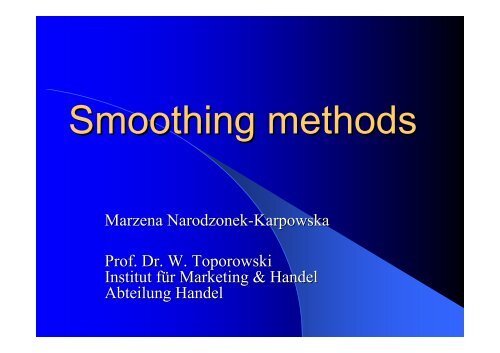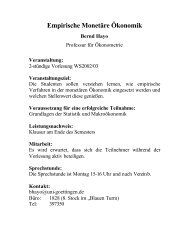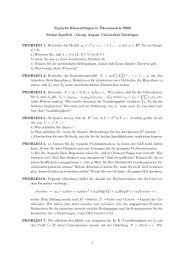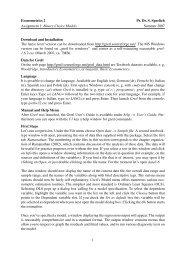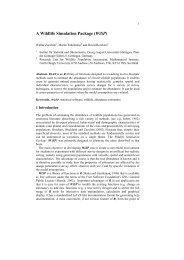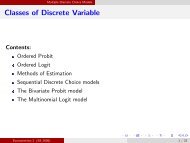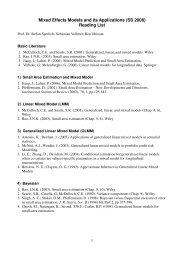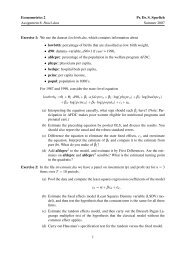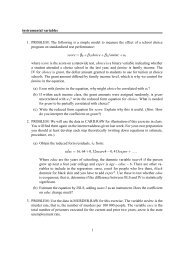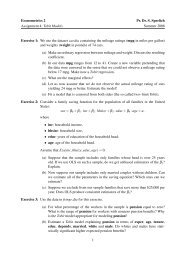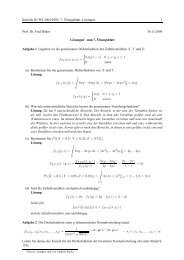Smoothing methods
Smoothing methods
Smoothing methods
Create successful ePaper yourself
Turn your PDF publications into a flip-book with our unique Google optimized e-Paper software.
<strong>Smoothing</strong> <strong>methods</strong><br />
Marzena Narodzonek-Karpowska<br />
Prof. Dr. W. Toporowski<br />
Institut für Marketing & Handel<br />
Abteilung Handel
What Is Forecasting?<br />
• Process of predicting a future event<br />
• Underlying basis of all business decisions<br />
You’ll never get it right. But, you can always get it less<br />
wrong.
Realities of Forecasting<br />
• Forecasts are seldom perfect<br />
• Most forecasting <strong>methods</strong> assume that there is some<br />
underlying stability in the system and future will be like<br />
the past (causal factors will be the same).<br />
• Accuracy decreases with length of forecast
Forecasting Methods<br />
Qualitative Methods are subjective in nature since they rely<br />
on human judgment and opinion.<br />
• Used when situation is vague & little data exist<br />
– New products<br />
– New technology<br />
• Involve intuition, experience<br />
Quantitative Methods use mathematical or simulation<br />
models based on historical demand or relationships<br />
between variables.<br />
• Used when situation is ‘stable’ & historical data exist<br />
– Existing products<br />
– Current technology<br />
• Involve mathematical techniques
Forecasting Methods<br />
Forecasting<br />
Methods<br />
Quantitative<br />
Qualitative<br />
Causal<br />
Time Series<br />
<strong>Smoothing</strong><br />
Trend<br />
Projection<br />
Trend Projection<br />
Adjusted for<br />
Seasonal Influence
What is a Time Series?<br />
By reviewing historical data over time, we can better understand<br />
the pattern of past behavior of a variable and better predict the<br />
future behavior.<br />
• Set of evenly spaced numerical data<br />
– Obtained by observing response variable at regular time<br />
periods<br />
• Forecast based only on past values<br />
– Assumes that factors influencing past, present, & future<br />
will continue<br />
• Example<br />
– Year: 2002 2003 2004 2005 2006<br />
– Sales: 78.7 63.5 89.7 93.2 92.1
Time Series Forecasting<br />
Time<br />
Series<br />
<strong>Smoothing</strong><br />
Methods<br />
No<br />
Trend?<br />
Yes<br />
Trend<br />
Models<br />
Moving<br />
Average<br />
Exponential<br />
<strong>Smoothing</strong><br />
Linear<br />
Quadratic<br />
Exponential<br />
Auto-<br />
Regressive
Components of a Time Series<br />
• The pattern or behavior of the data in a time series has<br />
several components.<br />
Trend<br />
Cyclical<br />
Seasonal<br />
Irregular
Trend Component<br />
• The trend component accounts for the gradual shifting of<br />
the time series to relatively higher or lower values over a<br />
long period of time.<br />
• Trend is usually the result of long-term factors such as<br />
changes in the population, demographics, technology, or<br />
consumer preferences<br />
Sales<br />
Upward trend<br />
Time
Cyclical Component<br />
• Any regular pattern of sequences of values above and below<br />
the trend line lasting more than one year can be attributed to<br />
the cyclical component.<br />
• Usually, this component is due to multiyear cyclical<br />
movements in the economy.<br />
Sales<br />
1 Cycle<br />
Year
Seasonal Component<br />
• The seasonal component accounts for regular patterns of<br />
variability within certain time periods, such as a year.<br />
• The variability does not always correspond with the<br />
seasons of the year (i.e. winter, spring, summer, fall).<br />
• There can be, for example, within-week week or within-day<br />
“seasonal” behavior.<br />
Sales<br />
Winter<br />
Summer<br />
Spring<br />
Fall<br />
Time (Quarterly)
Irregular Component<br />
• The irregular component is caused by short-term,<br />
term,<br />
unanticipated and non-recurring factors that affect the values<br />
of the time series.<br />
• This component is the residual, or “catch-all,” all,” factor that<br />
accounts for unexpected data values.<br />
• It is unpredictable.
Components of Time Series Data<br />
Trend<br />
Seasonal<br />
Cyclical<br />
Irregular
Components of Time Series Data<br />
Irregular<br />
fluctuations<br />
Cyclical<br />
Trend<br />
Seasonal<br />
1 2 3 4 5 6 7 8 9 10 11 12 13<br />
Year
<strong>Smoothing</strong> Methods<br />
• In cases in which the time series is fairly stable and has no<br />
significant trend, seasonal, or cyclical effects, one can use<br />
smoothing <strong>methods</strong> to average out the irregular component<br />
of the time series.<br />
• Common smoothing <strong>methods</strong> are:<br />
Moving Averages<br />
Weighted Moving Averages<br />
Centered Moving Average<br />
Exponential <strong>Smoothing</strong>
Moving Averages Method<br />
The moving averages method consists of computing an average<br />
of the most recent n data values for the series and using this<br />
average for forecasting the value of the time series for the next<br />
period.<br />
Moving averages are useful if one can assume item to be forecast<br />
will stay fairly steady over time.<br />
Series of arithmetic means - used only for smoothing, provides<br />
overall impression of data over time<br />
Moving Average =<br />
∑<br />
(most recent ndata values)<br />
n
Moving Averages<br />
Let us forecast sales for 2007 using a 3-period moving<br />
average.<br />
2002 4<br />
2003 6<br />
2004 5<br />
2005 3<br />
2006 7<br />
2007 ?
Time<br />
Moving Averages<br />
Response<br />
Yi<br />
Moving<br />
Total<br />
(n=3)<br />
Moving<br />
Average<br />
(n=3)<br />
1995 2002 4 NA NA<br />
1996 6 NA NA<br />
1997 2004 5 NA NA<br />
1998 2005 3 4+6+5=15 15/3=5.0<br />
1999 2006 7 6+5+3=14 14/3=4.7<br />
2000 2007 NA 5+3+7=15 15/3=5.0<br />
0032003
Sales<br />
8<br />
6<br />
4<br />
Moving Averages Graph<br />
Actual<br />
Forecast<br />
2<br />
95 96 97 98 99 00<br />
Year
Moving Averages Graph<br />
Actual<br />
Large n<br />
Demand<br />
Small n<br />
Time
Centered Moving Averages<br />
Method<br />
The centered moving average method consists of<br />
computing an average of n periods' data and associating it<br />
with the midpoint of the periods. For example, the average<br />
for periods 5, 6, and 7 is associated with period 6. This<br />
methodology is useful in the process of computing season<br />
indexes.<br />
5 10<br />
6 13 10+13+11: 3= 11.33<br />
7 11
Weighted Moving Averages<br />
• Used when trend is present<br />
– Older data usually less important<br />
• The more recent observations are typically<br />
given more weight than older observations<br />
• Weights based on intuition<br />
– Often lay between 0 & 1, & sum to 1.0<br />
WMA =<br />
Σ(Weight for period n) (Value(<br />
in period n)<br />
ΣWeights
2x 12
Weighted Moving Average Graph<br />
Actual<br />
Small weight on<br />
recent data<br />
Demand<br />
Large weight on<br />
recent data<br />
Time
Disadvantages of M.A. Methods<br />
• Increasing n makes<br />
forecast less sensitive to<br />
changes<br />
• Do not forecast trends<br />
well<br />
• Require sufficient<br />
historical data
Responsiveness of M.A. Methods<br />
The problem with M.A. Methods :<br />
• Forecast lags with increasing demand<br />
• Forecast leads with decreasing demand
Actual Demand, Moving Average,<br />
Sales Demand<br />
35<br />
30<br />
25<br />
20<br />
15<br />
10<br />
5<br />
0<br />
Weighted Moving Average<br />
Actual sales<br />
Jan<br />
Feb<br />
Mar<br />
Apr<br />
May<br />
Jun<br />
Weighted moving average<br />
Moving average<br />
Jul<br />
Month<br />
Aug<br />
Sep<br />
Oct<br />
Nov<br />
Dec<br />
All forecasting <strong>methods</strong> lag ahead of or behind actual demand
M.A. versus Exponential<br />
<strong>Smoothing</strong><br />
• Moving averages and weighted moving averages are<br />
effective in smoothing out sudden fluctuations in demand<br />
pattern in order to provide stable estimates.<br />
• Requires maintaining extensive records of past data.<br />
• Exponential smoothing requires little record keeping of<br />
past data.<br />
• Form of weighted moving average<br />
– Weights decline exponentially<br />
– Most recent data weighted most<br />
• Requires smoothing constant (α)(<br />
– Ranges from 0 to 1<br />
– Subjectively chosen
Forecasting Using <strong>Smoothing</strong> Methods<br />
Exponential<br />
<strong>Smoothing</strong><br />
Methods<br />
Single<br />
Exponential<br />
<strong>Smoothing</strong><br />
Double<br />
(Holt’s)<br />
Exponential<br />
<strong>Smoothing</strong><br />
Triple<br />
(Winter’s)<br />
Exponential<br />
<strong>Smoothing</strong>
Exponential <strong>Smoothing</strong> Methods<br />
• Single Exponential <strong>Smoothing</strong><br />
– Similar to single MA<br />
• Double (Holt’s) Exponential <strong>Smoothing</strong><br />
– Similar to double MA<br />
– Estimates trend<br />
• Triple (Winter’s) Exponential <strong>Smoothing</strong><br />
– Estimates trend and seasonality
Exponential <strong>Smoothing</strong> Model<br />
• Single exponential smoothing model<br />
F<br />
t+<br />
1<br />
=<br />
F<br />
t<br />
+ α(y<br />
t<br />
−<br />
F )<br />
t<br />
or:<br />
F<br />
t+<br />
1<br />
= αy<br />
t<br />
+<br />
(1−<br />
α)<br />
F<br />
t<br />
where:<br />
F t+1<br />
t+1 = forecast value for period t + 1<br />
y t = actual value for period t<br />
F t = forecast value for period t<br />
α = alpha (smoothing constant)
Single Exponential <strong>Smoothing</strong><br />
• A weighted moving average<br />
• Weights decline exponentially, most recent observation<br />
weighted most<br />
• The weighting factor is α<br />
– Subjectively chosen<br />
– Range from 0 to 1<br />
– Smaller α gives more smoothing, larger α gives less<br />
smoothing<br />
• The weight is:<br />
– Close to 0 for smoothing out unwanted cyclical and<br />
irregular components<br />
– Close to 1 for forecasting
Responsiveness to Different Values of α<br />
3000<br />
2500<br />
2000<br />
1500<br />
1000<br />
Actual demand<br />
alpha = 0.1<br />
alpha = 0.5<br />
alpha = 0.9<br />
1 2 3 4 5 6 7 8 9 10 11 12
Exponential <strong>Smoothing</strong> Example<br />
• Suppose we use weight α = 0.2<br />
Quarter<br />
(t)<br />
1<br />
2<br />
3<br />
4<br />
5<br />
6<br />
7<br />
8<br />
9<br />
10<br />
etc…<br />
Sales<br />
(y t<br />
)<br />
23<br />
40<br />
25<br />
27<br />
32<br />
48<br />
33<br />
37<br />
37<br />
50<br />
etc…<br />
Forecast<br />
from prior<br />
period<br />
NA<br />
23<br />
26.4<br />
26.12<br />
26.296<br />
27.437<br />
31.549<br />
31.840<br />
32.872<br />
33.697<br />
etc…<br />
Forecast for next period<br />
(F t+1<br />
)<br />
23<br />
(.2)(40)+(.8)(23)=26.4<br />
(.2)(25)+(.8)(26.4)=26.12<br />
(.2)(27)+(.8)(26.12)=26.296<br />
(.2)(32)+(.8)(26.296)=27.437<br />
(.2)(48)+(.8)(27.437)=31.549<br />
(.2)(48)+(.8)(31.549)=31.840<br />
(.2)(33)+(.8)(31.840)=32.872<br />
(.2)(37)+(.8)(32.872)=33.697<br />
(.2)(50)+(.8)(33.697)=36.958<br />
etc…<br />
F<br />
t+<br />
1<br />
= αy<br />
F 1<br />
= y 1<br />
since no<br />
prior<br />
informatio<br />
n exists<br />
t<br />
+ (1− α)F<br />
t
Sales vs. Smoothed Sales<br />
• Seasonal<br />
fluctuations have<br />
been smoothed<br />
• The smoothed<br />
value in this case<br />
is generally a little<br />
low, since the<br />
trend is upward<br />
sloping and the<br />
weighting factor is<br />
only 0.2<br />
Sales<br />
60<br />
50<br />
40<br />
30<br />
20<br />
10<br />
0<br />
1 2 3 4 5 6 7 8 9 10<br />
Quarter<br />
Sales<br />
Smoothed
Double Exponential <strong>Smoothing</strong><br />
• Double exponential smoothing is sometimes called<br />
exponential smoothing with trend<br />
• If trend exists, single exponential smoothing may need<br />
adjustment<br />
• There is a need to add a second smoothing constant to<br />
account for trend
Double Exponential <strong>Smoothing</strong><br />
Model<br />
Ct<br />
= αy<br />
t<br />
+ (1− α)(Ct− 1<br />
+ Tt<br />
−1)<br />
T<br />
t<br />
= β(C<br />
F = C +<br />
t+<br />
1<br />
y t = actual value in time t<br />
t<br />
t<br />
−<br />
T<br />
t<br />
C<br />
t−1<br />
α = constant-process smoothing constant<br />
β = trend-smoothing constant<br />
C t = smoothed constant-process value for period t<br />
T t = smoothed trend value for period t<br />
F t+1 = forecast value for period t + 1<br />
t = current time period<br />
)<br />
+ (1−<br />
β)<br />
T<br />
t−1
Double Exponential <strong>Smoothing</strong><br />
•Double Double exponential smoothing is generally done by<br />
computer<br />
•One One uses larger smoothing constants α and β when less<br />
smoothing is desired<br />
•One One uses smaller smoothing constants α and β when more<br />
smoothing is desired
Exponential <strong>Smoothing</strong> Method<br />
You want to forecast sales for 2007 using exponential<br />
smoothing (α(<br />
= 0.10). The 2001 forecast was 175.<br />
2002 180<br />
2003 168<br />
2004 159<br />
2005 175<br />
2006 190
Exponential <strong>Smoothing</strong> Method<br />
Time<br />
Actual<br />
F t = F t-1 + α (A t-1 - F t-1 )<br />
Forecast,<br />
(α =0.10)<br />
2002 180 175.00 (Given)<br />
2003 168 175.00 + .10(180 - 175.00) = 175.50<br />
2004 159 175.50 + .10(168 - 175.50) = 174.75<br />
2005 175 174.75 + .10(159 - 174.75) = 173.18<br />
2006 190 173.18 + .10(175 - 173.18) = 173.36<br />
2007 NA 173.36 + .10(190 - 173.36) = 175.02<br />
F t
Exponential <strong>Smoothing</strong> Graph<br />
Sales<br />
190<br />
180<br />
170<br />
160<br />
150<br />
140<br />
Actual<br />
Forecast<br />
Year<br />
02 03 04 05 06 07
Exponential <strong>Smoothing</strong> Graph<br />
Actual<br />
Small α<br />
Demand<br />
Large α<br />
Time
Comparing <strong>Smoothing</strong> Techniques<br />
• Let us determine the smoothing technique that is best for<br />
forecasting these sales data : A two period moving<br />
average, a three period moving average, exponential<br />
smoothing (α=0.1),(<br />
or exponential smoothing (α=0.2)(<br />
Week<br />
Sales<br />
Week<br />
Sales<br />
1 110 6 120<br />
2 115 7 130<br />
3 125 8 115<br />
4 120 9 110<br />
5 125 10 130
Measures of Forecast Accuracy<br />
Mean Squared Error (MSE)<br />
The average of the squared forecast errors for the historical<br />
data is calculated. The forecasting method or parameter(s)<br />
which minimize this mean squared error is then selected.<br />
Mean Absolute Deviation (MAD)<br />
The mean of the absolute values of all forecast errors is<br />
calculated, and the forecasting method or parameter(s) which<br />
minimize this measure is selected. The mean absolute<br />
deviation measure is less sensitive to individual large forecast<br />
errors than the mean squared error measure.<br />
You may choose either of the above criteria for evaluating the<br />
accuracy of a method (or parameter).
2 period moving average<br />
Sales n=2 Error<br />
Week (t ) Y t F t (Y t - F t ) (Y t - F t ) 2<br />
1 110<br />
2 115 #NV<br />
3 125 112,5 12,5 156,25<br />
4 120 120 0 0<br />
5 125 122,5 2,5 6,25<br />
6 120 122,5 -2,5 6,25<br />
7 130 122,5 7,5 56,25<br />
8 115 125 -10 100<br />
9 110 122,5 -12,5 156,25<br />
10 130 112,5 17,5 306,25<br />
11 120<br />
MSE 98,4375
3 period moving average<br />
Sales n=3 Error<br />
Week (t ) Y t F t (Y t - F t ) (Y t - F t ) 2<br />
1 110<br />
2 115 #NV<br />
3 125 #NV<br />
4 120 116,6667 3,333333 11,11111<br />
5 125 120 5 25<br />
6 120 123,3333 -3,33333 11,11111<br />
7 130 121,6667 8,333333 69,44444<br />
8 115 125 -10 100<br />
9 110 121,6667 -11,6667 136,1111<br />
10 130 118,3333 11,66667 136,1111<br />
11 118,3333<br />
MSE 69,84127
Exponential smoothing (α=0.1)(<br />
Sales α=0.1 Error<br />
Week (t ) Y t F t (Y t - F t ) (Y t - F t ) 2<br />
1 110 #NV<br />
2 115 110 5 25<br />
3 125 110,5 14,5 210,25<br />
4 120 111,95 8,05 64,8025<br />
5 125 112,755 12,245 149,94<br />
6 120 113,9795 6,0205 36,24642<br />
7 130 114,5816 15,41845 237,7286<br />
8 115 116,1234 -1,1234 1,262016<br />
9 110 116,0111 -6,01106 36,13279<br />
10 130 115,4099 14,59005 212,8696<br />
11<br />
MSE 108,248
Exponential smoothing (α=0.2)(<br />
Sales α=0.2 Error<br />
Week (t ) Y t F t (Y t - F t ) (Y t - F t ) 2<br />
1 110 #NV<br />
2 115 110 5 25<br />
3 125 111 14 196<br />
4 120 113,8 6,2 38,44<br />
5 125 115,04 9,96 99,2016<br />
6 120 117,032 2,968 8,809024<br />
7 130 117,6256 12,3744 153,1258<br />
8 115 120,1005 -5,10048 26,0149<br />
9 110 119,0804 -9,08038 82,45337<br />
10 130 117,2643 12,73569 162,1979<br />
11<br />
MSE 87,91584
Comparing <strong>Smoothing</strong><br />
Techniques<br />
• Since the three period moving average technique (MA 3 )<br />
provides to lowest MSE value, this is the best smoothing<br />
technique to use for forecasting these Sales data in our<br />
example.
Thank You for Your<br />
Attention
References<br />
References<br />
• www<br />
www.lsv<br />
lsv.uni<br />
.uni-saarland<br />
saarland.de/Seminar/LMIR_WS0506/LM4IR_<br />
.de/Seminar/LMIR_WS0506/LM4IR_slides<br />
slides/<br />
Alejandro<br />
Alejandro_Figuera<br />
Figuera_<strong>Smoothing</strong><br />
<strong>Smoothing</strong>_Methods<br />
Methods_for<br />
for_LM_in_IR.<br />
_LM_in_IR.ppt<br />
ppt<br />
• www<br />
www.forecast<br />
forecast.umkc<br />
umkc.edu<br />
edu/ftppub<br />
ftppub/formula<br />
formula_pages<br />
pages/ch04lec.<br />
/ch04lec.ppt<br />
ppt<br />
• www<br />
www.angelfire<br />
angelfire.com<br />
com/empire2/qnt531/workshop4.<br />
/empire2/qnt531/workshop4.ppt<br />
ppt<br />
• www<br />
www.swlearning<br />
swlearning.com<br />
com/quant<br />
quant/asw<br />
asw/sbe<br />
sbe_8e/<br />
_8e/powerpoint<br />
powerpoint/ch18.<br />
/ch18.ppt<br />
ppt<br />
• www<br />
www.coursesite<br />
coursesite.cl.uh.<br />
.cl.uh.edu<br />
edu/BPA/<br />
/BPA/revere<br />
revere/DSCI5431/<br />
/DSCI5431/gradqntch<br />
gradqntch_16&14.<br />
_16&14.ppt<br />
ppt<br />
• www<br />
www.cs<br />
cs.wright<br />
wright.edu<br />
edu/~<br />
/~rhill<br />
rhill/EGR_702/<br />
/EGR_702/Lecture<br />
Lecture%203.<br />
%203.ppt<br />
ppt<br />
• www<br />
www.lehigh<br />
lehigh.edu<br />
edu/~rhs2/ie409/<br />
/~rhs2/ie409/BasicForecastingMethods<br />
BasicForecastingMethods.ppt<br />
ppt<br />
• www<br />
www.cob<br />
cob.sjsu<br />
sjsu.edu<br />
edu/hibsho<br />
hibsho_a/ballou08aconcforecast.PPT<br />
_a/ballou08aconcforecast.PPT<br />
• www<br />
www.mgtclass<br />
mgtclass.mgt<br />
mgt.unm<br />
unm.edu<br />
edu/MIDS/<br />
/MIDS/Kraye<br />
Kraye/Mgt<br />
Mgt%20300/<br />
%20300/Slide<br />
Slide%20Show%2<br />
%20Show%2<br />
0Week%20%232%20MGT%20300%20Forecasting.<br />
0Week%20%232%20MGT%20300%20Forecasting.ppt<br />
ppt<br />
• www<br />
www.infohost<br />
infohost.nmt<br />
nmt.edu<br />
edu/~<br />
/~toshi<br />
toshi/EMGT%20501_<br />
/EMGT%20501_files<br />
files/Lectures<br />
Lectures/EMGT50113t<br />
/EMGT50113t<br />
hweek.<br />
hweek.ppt<br />
ppt<br />
• www<br />
www.docp<br />
docp.wright<br />
wright.edu<br />
edu/bvi<br />
bvi/classes<br />
classes/MBA780/MBA%20<br />
/MBA780/MBA%20Forecasting<br />
Forecasting-1.<br />
1.ppt<br />
ppt<br />
• www<br />
www.cbtpdc<br />
cbtpdc.tamu<br />
tamu-commerce<br />
commerce.edu<br />
edu/gbus302/gbus302/ba578/Chapter14.<br />
/gbus302/gbus302/ba578/Chapter14.ppt<br />
ppt<br />
• www<br />
www.mgtclass<br />
mgtclass.mgt<br />
mgt.unm<br />
unm.edu<br />
edu/Weber/<br />
/Weber/Mgt<br />
Mgt%20720/Unit%201/4.0_%20intro<br />
%20720/Unit%201/4.0_%20intro<br />
%20to%20forecasting.<br />
%20to%20forecasting.ppt<br />
ppt


